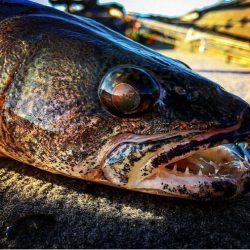Here are some facts from Walleye Central we would like to share with you. You may or may not know this info about walleye:
 Walleye can live up to 20 years, and grow slowly in the northerly most part of their range.
Walleye can live up to 20 years, and grow slowly in the northerly most part of their range.- Walleye have their ‘taste buds’ in their lips – thousands of them!
- In Canyon Ferry alone, walleyes eat more than 750,000 pounds of perch each year—that’s about 4 pounds of perch per walleye. (via MT FWP)
- Walleye, it’s said, have a ‘soft mouth’. This is false, in fact the membrane around a walleye’s mouth is hard and brittle. Because it is so hard and brittle, fish hooks/lures will easily tear and break out of a walleye’s mouth, giving one the impression that the mouth is ‘soft’.
- Walleye don’t very often go deeper than 60 feet. Most often they are found in water between 20 feet deep and 60 feet deep, depending on the water temperature, bait, oxygen content, and time of day/night/year.
- Because many reservoirs have relatively little natural walleye spawning habitat, FWP rears and stocks about 40 million walleyes each year. Roughly 90 percent of these are mosquito-sized fry. Biologists take care to not overstock reservoirs, which can cause stunted growth. (via MT FWP)
- Walleye are very prolific; a large walleye female can lay up to 600,000 eggs per year.
- Walleye can, and do travel extensively within their waterbody. On large lakes, such as Lake Erie, walleye will travel up to fifty miles in a single night. Normally though, they won’t travel more than several miles, unless in search of their favoured water temperature or food.
- The walleye name comes from its large, glassy pupils. The opaque quality of the eye comes from a reflective layer of pigment, called the tapetrum lucidum, in the inner eye. The pigment layer allows walleyes to see prey at night or in murky water. (via MT FWP)
- The best walleye fishing is usually in early summer. Perch and other prey spawn in the spring, and their abundant young are too small for adult walleyes to eat until midsummer. As a result, walleyes more eagerly attack bait and lures. Fishing picks up again in fall as walleyes beef up in preparation for winter and forage fish numbers, reduced by several months of predation, decline. The years of best fishing are those when lakes produce few forage fish, increasing the odds that walleyes will go after an angler’s lure or bait. (via MT FWP)
(Feature photo via Mike J. Leung Photography)